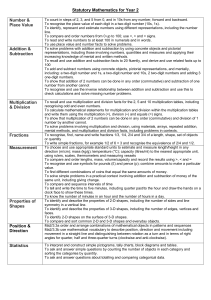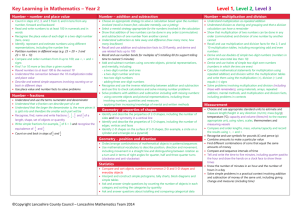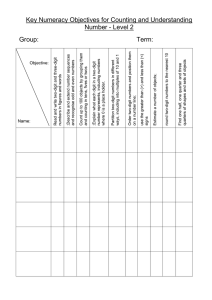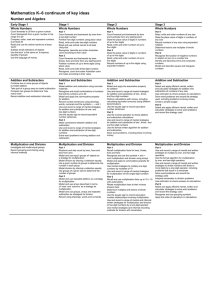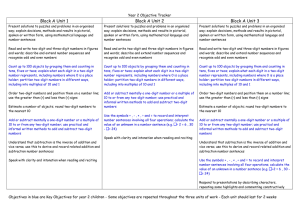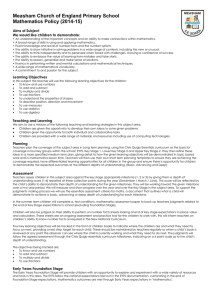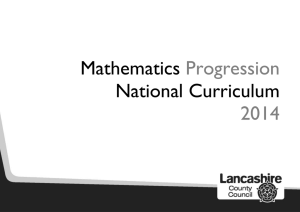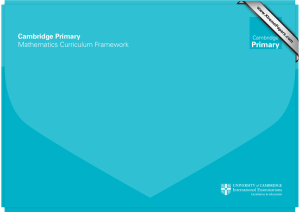Stage 2 Maths Targets
advertisement
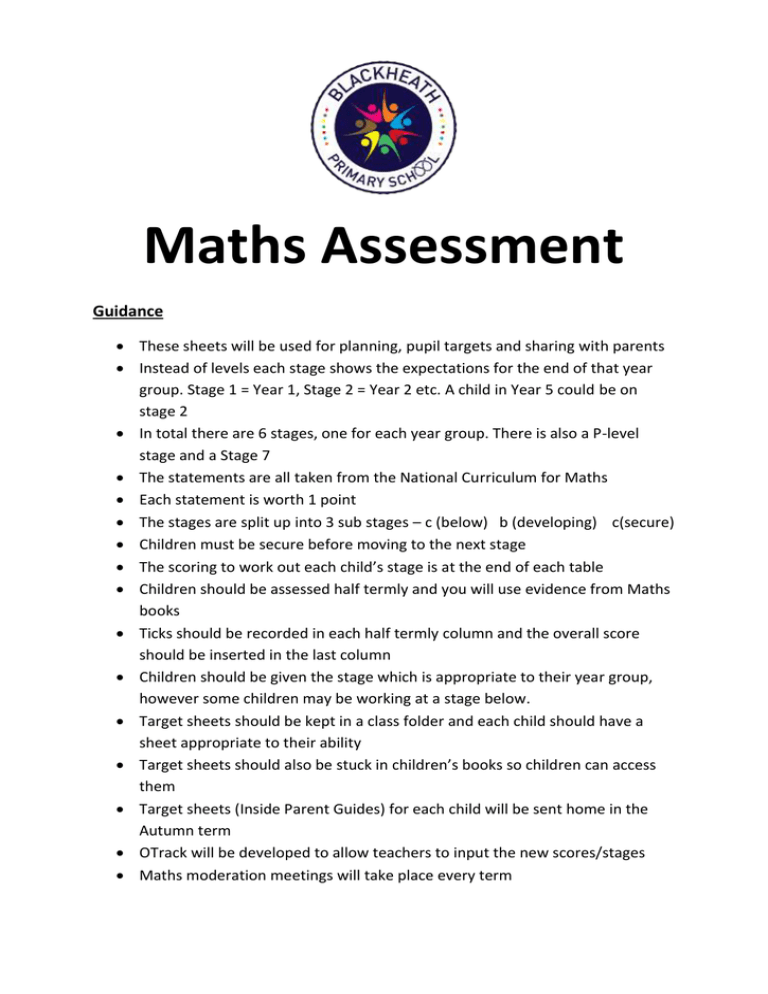
Maths Assessment Guidance These sheets will be used for planning, pupil targets and sharing with parents Instead of levels each stage shows the expectations for the end of that year group. Stage 1 = Year 1, Stage 2 = Year 2 etc. A child in Year 5 could be on stage 2 In total there are 6 stages, one for each year group. There is also a P-level stage and a Stage 7 The statements are all taken from the National Curriculum for Maths Each statement is worth 1 point The stages are split up into 3 sub stages – c (below) b (developing) c(secure) Children must be secure before moving to the next stage The scoring to work out each child’s stage is at the end of each table Children should be assessed half termly and you will use evidence from Maths books Ticks should be recorded in each half termly column and the overall score should be inserted in the last column Children should be given the stage which is appropriate to their year group, however some children may be working at a stage below. Target sheets should be kept in a class folder and each child should have a sheet appropriate to their ability Target sheets should also be stuck in children’s books so children can access them Target sheets (Inside Parent Guides) for each child will be sent home in the Autumn term OTrack will be developed to allow teachers to input the new scores/stages Maths moderation meetings will take place every term Number & Place Value Count in steps of 2, 3, and 5 from 0, and in tens from any number, forward and backward. Know the value of each digit in a two-digit number. Estimate using number lines. Compare and order numbers from 0 up to 100; using < > and = Read & write numbers to at least 100 in numerals (digits) and words. Use place value to solve addition and subtraction problems including quantities, money and measures. Recall and use addition and subtraction facts to 100 confidently. Add and subtract a two-digit number and ones (43 + 3, 43-3) . + and - Add and subtract a two-digit number and tens (43 + 30, 43-30). Add and subtract two two-digit numbers (43 + 33, 43-33). Add and subtract three one-digit numbers (4 +7 +9, 9-7-4). Show that addition of two numbers can be done in any order (commutative) and subtraction cannot. Use inverse operations (addition to check subtraction) to check answers and solve missing number problems. x and ÷ Recall and use multiplication and division facts for the 2, 5 and 10 multiplication tables, including recognising odd and even numbers. Write accurate calculations using x ÷ and = signs (e.g. 3 ⃝ 3 = 9). Show that multiplication of two numbers can be done in any order (commutative) and division cannot. Measurement Fractions Solve problems involving multiplication and division, using, arrays, repeated addition and mental methods. Recognise, find, name and write fractions 1/3, 1/4 , 2/4 and 3/4 of a length, shape, set of objects or quantity. Write simple fractions for example, 1/2 of 6 = 3 and recognise 2/4 and ½ are equivalent (the same). Use appropriate standard units to estimate and measure length/height (m/cm); mass (kg/g); temperature (°C); capacity (litres/ml) to the nearest unit. Use rulers, scales, thermometers and measuring containers. Compare and order lengths, mass, volume/capacity and record the results using < > and = Recognise and use symbols for pounds (£) and pence (p) and combine (add together) amounts to make a given value. Find different combinations of coins that equal the same amounts of money. Su2 Su1 Sp2 Sp1 A2 A1 Stage 2 Maths Targets Solve simple problems practically involving addition and subtraction of money, including giving change. Compare and order lengths of time. Tell and write the time to five minutes, including quarter past/to and draw the hands on a clock face accurately. Statistics Position & Direction Geometry Know the number of minutes in an hour and hours in a day. Know, compare and sort the properties of 2-D shapes, including the number of sides and line symmetry in a vertical line. Know, compare and sort the properties of 3-D shapes, including the number of edges, vertices and faces. Identify 2-D shapes on the surface of 3-D shapes (cube has 6 square faces). Order objects in patterns and sequences. Describe rotation as a turn, right angles for quarter, half and threequarter turns (clockwise and anticlockwise). Interpret and create simple pictograms, tally charts, block diagrams and simple tables. Ask and answer questions about data including most/least and total. 0-11 = 2c 12-22 = 2b 23-34 = 2a

